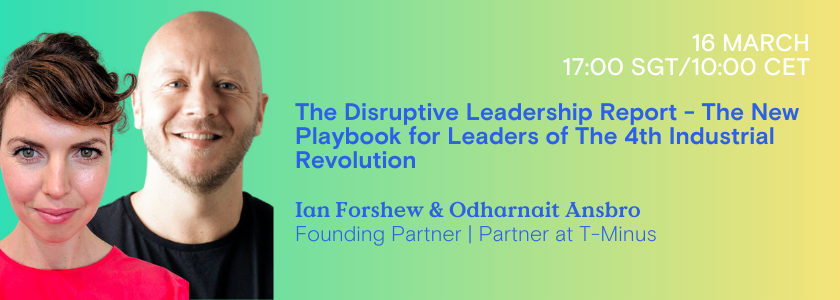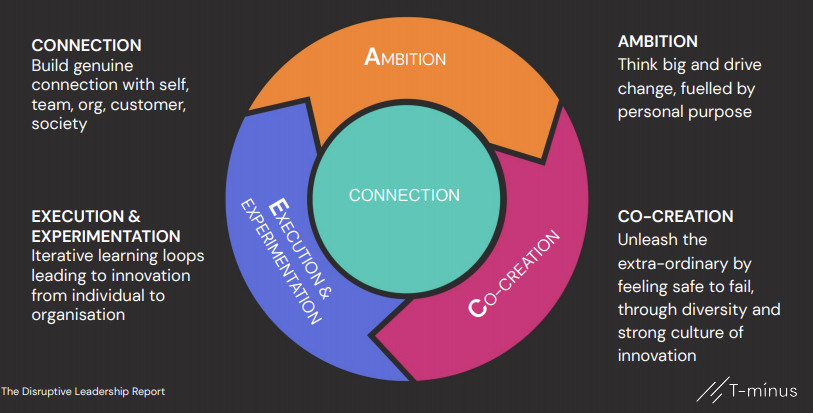We are in times of unprecedented disruption and change – climate change, the global pandemic and rapid, seismic shifts in technology are reshaping how we work, live and consume at a pace we can barely comprehend.
Social and political upheaval are forcing businesses to question their own role in building societies that work for everyone and their part in everything from inequality and racism to free speech.
These challenges require radical new thinking at a systemic level – businesses need to rethink and reshape their own purpose, products and operating model if they want to not only survive but build a sustainable future.
Last year, T-minus created the Disruptive Leadership Report. In it, we brought together insights from our work with leaders at the cutting edge of innovation with research we conducted with 120 leaders from startups, scaleups, leading technology companies and some of the largest corporations on the planet, like Microsoft, Shell and Unilever.
Our question was this: why do some companies thrive in the face of disruption while others collapse? And what are their leaders doing differently?
We found disruption was everywhere – across size, industry and geography. 53% of our survey respondents said their businesses were disrupted or highly disrupted, yet only 18% said their organizations' response was highly effective.
It’s about people
When we looked at the differences between organizations responding well to disruption (who we call ‘the Disruptors’) and those that weren’t (the Disrupted) we found that it was people and, crucially, leaders that made the difference. Amongst ‘the Disrupted’, only 19% agreed that their leaders had the capabilities needed to succeed.
Disrupted leaders are doubling down and protecting what they have, while disruptive leaders are seizing the opportunities and taking bold risks to create something new. They’re also adept at building inclusive teams and cultures where everyone can bring their best self and feel safe to fail and try new things.
The report identifies four big shifts and twenty rules for a new playbook for leaders of the 4th industrial revolution.
For the full report click here
- From ‘Blind to the problem’, to ‘Open, humble and hungry to learn’
- From ‘No north star’, to ‘Clear, purpose-driven ambition’
- From ‘Not safe to fail’ to ‘Unleashing Extra-ordinary’
- From ‘Can’t balance execution and innovation’ to ‘Iterative Learning Loops’
From ‘Blind to the problem’, to ‘Open, humble and hungry to learn’
“In an alarming number of cases, disbelief that there is a problem creates a significant lack of urgency to act.”
Deborah Pellen, Global Innovation Director, Bacardi
The difference between being a disruptor or the disrupted lies in your ability to see things others don’t.
Almost half the respondents said lack of consumer focus was a blocker to innovation. They lack the capacity and the willingness, often through their own arrogance (according to one interviewee) to really get to know their consumers.
Disruptors practice ‘beginner’s mind’ – they challenge themselves to look at existing problems in new ways. They have the ‘cognitive flexibility’ needed to unlearn existing ways of thinking and embrace new ones. They focus on learning over knowing.
Disruptive organizations are relentlessly focused on bringing the outside in. They constantly scan their environment, looking for diverse perspectives and ideas from across the ecosystem.
Disruptive leaders are as good at synthesis as they are at analysis – they can pull back and see the whole picture and find connections between unlikely sources to generate creative insights.
From ‘No north star’, to ‘Clear, purpose-driven ambition’
“Innovation requires long-term commitment but fear of poor stock market reaction to experimentation, combined with bonuses based on current year performance drive short-term decision-making. It means leaders are often fighting the wrong fight.”
Alex Long, MD, McClaren Motors
Disruptive leaders are shooting for the stars, propelled by purpose and prepared to change course quickly based on data to help reach their ultimate goal.
One of biggest problems for disrupted organisations is they lack ambition. Even tech giants like Amazon know that if they’re only focused on protecting what they have and delivering on reliable bets eventually they’ll fail.
The lack of ambition is often linked to a lack of purpose. Without a strong sense of personal purpose, leaders are often unwilling to set big goals and lack the determination to deliver on them.
With a clear goal in mind, the report shows that disruptive companies succeed by having clearly defined metrics and constantly monitoring their progress. They gather feedback and adjust their direction as they go, gradually finding the right path towards their north star.
From ‘Not safe to fail’ to ‘Unleashing Extra-ordinary’
“Organisations talk about failing fast but it's counter-culture and very hard to embed.”
Nathan Ansell, Marketing Director, Marks and Spencer
Disruptive organizations create fearless, empowered and resilient leaders. Diversity is celebrated and ideas come from everywhere.
Disruptors create a culture where failure is seen as a learning opportunity. The report found that when leaders create psychological safety and practice growth mindset, their organization’s response to disruption was more effective. Indeed, in organizations responding well, leaders were 21% more likely to embrace failure as an opportunity for learning.
Disruptive orgs had a strong culture of innovation where diversity is celebrated and employees are expected to generate new ideas. Disruptors understand the importance of cultivating resilience to change in themselves, their teams and their organizations. In our survey, we found that in organizations with effective responses to disruption, leaders were 44% more likely to be resilient in the face of challenge
From ‘Can’t balance execution and innovation’ to ‘Iterative Learning Loops’
“What is the future of leadership might be the wrong question. What I think we will see is a self-organizing, non-hierarchical, bottom up, democratised, more conscious model of leadership.”
Gib Bulloch, Former Executive Director at Accenture
Successful organizations are creation engines that balance execution and innovation. They remove silo’s and hierarchy and move iteratively forwards.
Disrupted organizations are either great at execution or innovation – but they don’t balance the two very well. Large corporates are set up to deliver flawless execution and fall down when they try to deliver innovation. On the flipside, small organizations, growing rapidly are often slowed down by their inability to execute because they lack process and structure.
Amongst the biggest blockers to innovation, 72% said silos and 61% said top down decision-making were blockers to innovation. Disruptive organizations are flexible, open, inclusive, and nonhierarchical; teams are organized around creating consumer value and empowered to make decisions
They work in iterative learning loops – applying agile principles not only to their products but to building their culture, systems and processes. Importantly, says Stephan Thoma, former Director of L&D globally at Google, “they capture and institutionalise their learning, increasing the intellectual capital of the organization as they go.” This focus on learning and agility over fixed process and structure is what gives them a competitive advantage.
T-minus have developed ACE 2.0, a model for diagnozing and building new disruptive leadership capability in organizations of all sizes.
The 4 shifts and 20 rules have been codified into a simple model for building disruptive leadership capability. To find out more about how to build this capability in your organization, download the full report.
This is a guest post by Ian Forshew and Odharnait Ansbro of T-minus. T-minus have helped organizations build disruptive leadership capability, ranging from Monzo Bank and Deliveroo through to Unilever and the Guardian.

Want to hear more from Ian and Odharnait? Join their Trending Topic Talk on 16 March, 17:00 SGT/10:00 CET. You’ll come away from the session with an insight of how to create culture where leaders and teams have the mindset and skills set to be the disruptors; connecting with themselves, their customers, and the world around them, setting purposeful ambition, fostering an environment of co-creation, whilst executing and innovating at at the same time. It's free to join - RSVP here.


